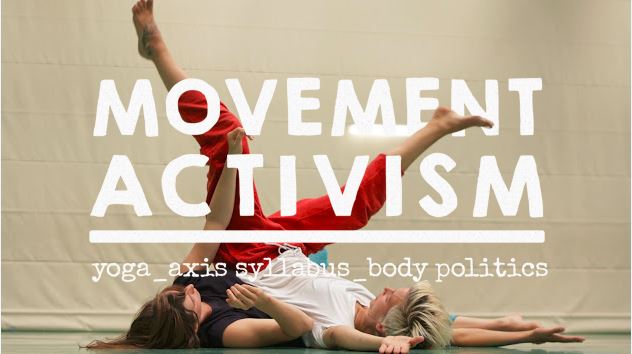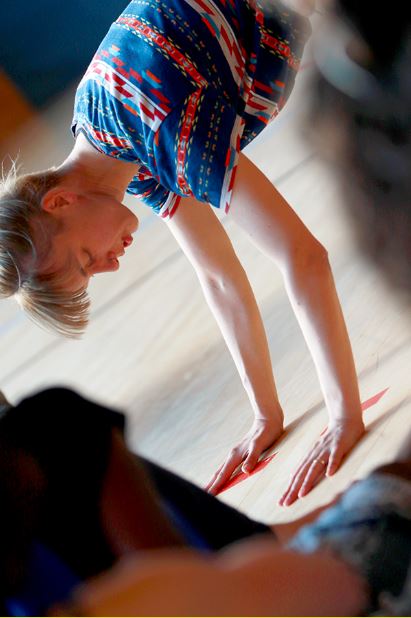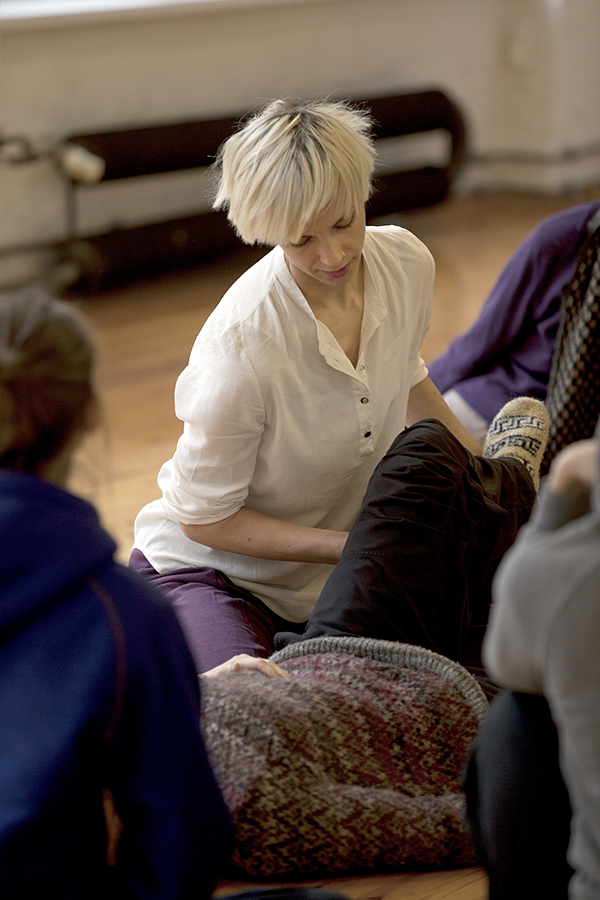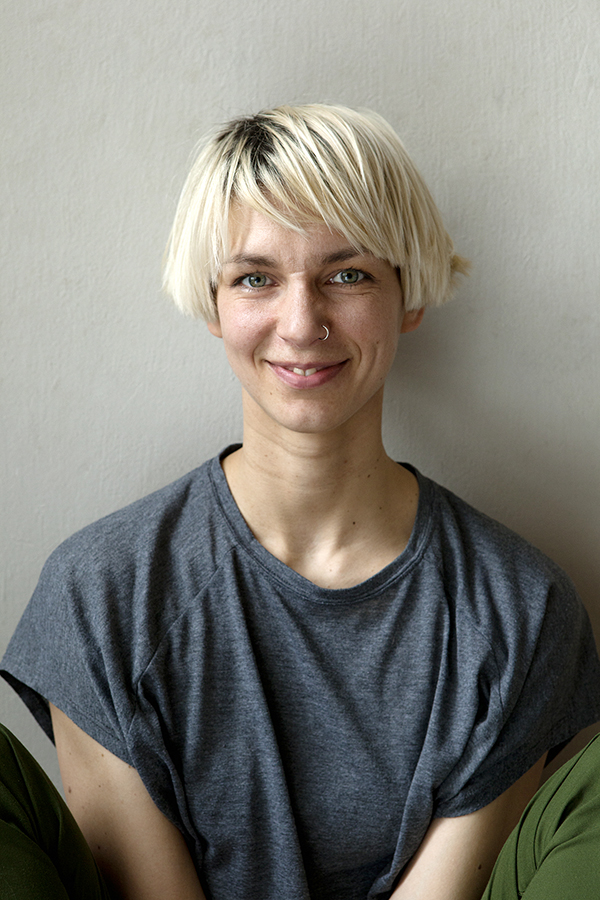Movement Activism
An Interview with Diana Thielen
Diana Thielen, based in Berlin, Germany, is a dancer/performer, teacher of the Axis Syllabus, dedicated feminist, and student of education and gender studies. In addition to teaching and performing, she runs the blog movementactivism.com, where she writes about her intersectional inquiry and fascination with the human body. In this interview, she shares her motivations to deconstruct discourses about movement, dance and yoga.
~~
What is your own background in dance and movement?
My passion for dancing actually began quite banally with the discovery of films like Flashdance or Fame. I found the women in the films inspiring: they were young, of course pretty, athletic, and always so incredibly strong-willed and determined. I started with jazz dance in a gym in my early teens. It was not until I was 18 years old when I encountered modern dance, contemporary dance, and participated in some youth dance theater projects. When I was in my early 20s, I started my studies in Austria at the Salzburg Experimental Academy of Dance. I’ve studied contemporary dance and its related “techniques” for over a decade now, both within a dance institution (SEAD), as well as in various workshops or intensives. In 2010, my intensive inquiry of the Axis Syllabus started, and since 2015 I’ve taught Axis Syllabus in various circumstances.
What was the impetus behind starting movementactivism.com?
I was looking for a way to give my own research a space and a voice. The blog offers the possibility to make my research – and the inquiry behind it – public, and thus to achieve focus. I came to the point where I felt a desire to share my thoughts in public, without finding this public exclusively through classes or performances.
Above all, the blog is dedicated to my research and serves the presentation of my work. I also advertise my workshops, projects and classes on it. I have recently sensed an urgent need to give other authors the opportunity to write. At the moment, however, I am still hesitant to offer other writers the space. I do not want other authors to feel misrepresented, so I am being patient and will allow the blog to grow if people are interested in it.
Why the name “movement activism”? How do you define movement activism?
Next to my deep desire for moving, dancing and creating, my work investigates my understanding of embodied societal behavior. I have a fascination with the human body in all its expression: how we move, how we present ourselves, how we position ourselves socially, how we change and adapt over our lifetimes in response to various challenges.
I remember one of the first workshops I attended with Frey Faust [author and initiator of Axis Syllabus] – he described Axis Syllabus as a toolbox or a lens. It’s a specific perspective to investigate bodies in motion, to dive deeper in the examination of diverse movement disciplines, methods, and ideas of training.
Through this specific perspective, I have come to know my body in dance settings, as well as in the postural yoga practice, differently: It clearly has changed my way of practicing and teaching movement classes.
However, what has always accompanied my explorations were the multiple embodied and lived social and cultural relations and experiences. With this experience and lens, the reality of our bodies cannot be encompassed by biology and physics alone. One “toolbox,” or lens, is the one which is enriched by the Axis Syllabus. This includes the study of anatomies, biomechanics and physics. The other “toolbox,” or the other lens, is what I call “Bodypolitics.” (I have written a blogpost about this: https://www.movementactivism.com/single-post/2016/10/26/activism-dance-yoga.)
Photo by Patrick Beelaert
What is the guiding philosophy of the site?
In short, I’d say: “deconstruct to construct.” This thought is inspired by an interview with Gayatri Chakravorty Spivak, where she shares her first steps as a writer/theorist. I might deconstruct Yoga-Asanas, or criticize the working conditions of a freelance-dancer, as well as bring up uncomfortable questions like: What is the relation of the festival/class/workshop to the neo-liberal economic system? How do social and political decisions regarding dis-ability determine different people’s participation in social spaces? And how does that affect our perceptions and constructions of health?
All topics are an attempt to generate alternative approaches, or to question how we do what we do – to question one’s own privileges and relate oneself to social realities.
Why do you think it’s important to write about movement, particularly Axis Syllabus and yoga?
My work is mostly in the field of hatha yoga and dance/performance. The body is the main instrument in both of these practices, although their objectives may be considered fundamentally different.
In my experience, the body is quickly perceived normatively. It seems almost as if many people constantly search for the “one” truth. I am not interested in finding “one” answer. My interest lies currently in deconstruction and contextualization.
For example, I often see white yoga teachers inventing something “new.” More frequently, I observe the inclusion of fundamental biomechanical knowledge within the practice, which is great! The downside of it is that new approaches are advertised as “the” answer, with the incapacity to reflect on the white colonial behavior in it, as well as its marketing ideas within our neo-liberal structure.
Biomechanics alone are not the answer. That leaves out the interrelation of bodies, minds, embodied societal behavior, social reality and social relations. It’s about time to deconstruct our/my whiteness and appropriation. I keep this in my mind while deconstructing the postural yoga with my biomechanical lens. It sometimes creates a lot of friction.
In the end, I am trying to serve my students. My students in my regular classes in Berlin might enjoy the asana-practice which is influenced by all my biomechanical inquiry, and this inquiry might also support a body-positive approach but, in the end, they need some space to breath and be. In that moment, the creation of a (queer-)feminist space, which is showing care and solidarity, is more important than the correct application of the spinal mechanics on the mat.
How do you decide on your projects, like “LABOUR_LAB” or “perspEGGtives”? How do they support movementactivism.com, and how does movementactivism.com support the projects?
For a long time, I did not know which way I would like to work artistically. Actually, I’ve only been performatively active for about two years, and the decisive factor for me was the work of Alisa Tretau in her “Sweet Peep Salon,” a body-and sex-positive immersive performance space. Both “LABOUR_LAB” and “perspEGGtives” emerged from this performance.
The projects support the overall idea behind the blog: to contextualize the body, to ask questions about normative knowledge in body-minds, as well as about societal structures, and to essay alternative working conditions. This is an important aspect: While working with Sarah Bouars and Alisa Tretau, our work was neither funded, nor were the chosen topics easy ones to deal with. (In “LABOUR_LAB,” we asked questions about becoming pregnant, like ‘Who is supposed or not supposed to get pregnant?’) Throughout the creative process, we were challenged by our daily needs, both financially as well as emotionally. We always aimed to create a space defined by solidarity and caring for each other, but this aim was challenged on a regular basis by environmental conditions.
Is movementactivism.com funded in any way? If not, are you interested in funding?
I sincerely haven’t thought about that. It is not funded, and I haven’t even checked out options how to fund a blog. I also wonder about all the admin work which would come with application for funding. On the other hand, there is lots of unpaid work in the blog. I take that as inspiration for the future. If it were funded, I could invite many more voices, which definitely would serve the idea behind it.
What do you hope to achieve through movementactivism.com?
To network. To create a dialogue with the will to deconstruct. To reflect upon embodied societal behaviors. To bring a power-critical perspective to yoga and dance.
~~
To learn more, visit www.movementactivism.com.




